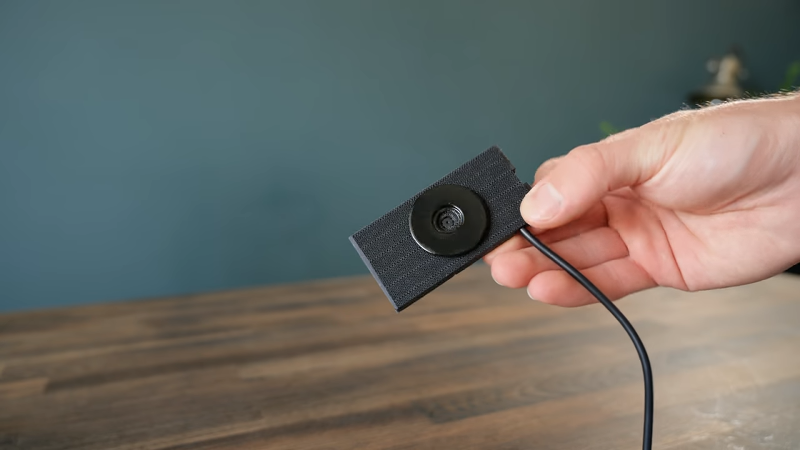Like everyone lately, [Matt] has been spending more time doing video conferencing lately. The problem is you naturally want to look at the screen, but that means you aren’t looking at the camera and, thus, you aren’t making eye contact. If you use a laptop, there is a relatively easy fix, although it isn’t particularly stylish. [Matt] built a black shroud out of foam board and put in two-way mirror. How does that help? Well, with the set up, you can put a very thin black web camera pointing up towards the mirror. Because the shroud is dark, you can see the screen through the mirror, but the camera sees you.
Where do you get a thin black web camera? You make one from an old laptop camera. They are tiny and easy to repurpose, a trick [Matt] has shared before. As a bonus, the post shows an easy way to take an LED strip and make a diffused light for lighting up your webcam call.
It looks like the downside is it will make the keyboard difficult to use, so you might want to pair this with a Bluetooth keyboard. It is also a little bulky, but if you are on the go, it looks like you could remove the mirror, fold the shroud, and the whole thing would lay flat for transport.
Even if you don’t want to improve your video chat, there are a few gems here. The light is simple enough and would be a good way to use a little bit of extra LED lighting. We can think of lots of reasons we want a thin web camera. But what struck us the most was the possibility of using this as a teleprompter. If you had text on your screen scrolling (or used your mouse to scroll, you could read the text while looking straight at the camera. Just the thing the next time you run for office.
Most of the two way mirrors we see are for infinity mirrors. If you try this project, maybe add some motors and eye tracking so it forces you to make eye contact.
















It’s like a prompter….. ;-)
You can display your screen on the text dedicated area and plug your webcam to an usb port and put it in front of the glass.
I guess I have been using this for the past 10 years.
This is an ingenious version of a victorian theatrical ‘special effect’ called Pepper’s Ghost. Nice to see it applied to modern tech.
This is an old filmmaker’s trick (pre teleprompter even) and certainly good, simple build intended for portability (very useful for most people stuck on Zoom these days).
If you want to up the game with much less portability, particularly for desk monitors, build the shroud as described but have the camera (any camera, including a big hi-res one or even a cine or full tilt broadcast unit) view downward rather than upward and angle the mirror the other way. If the camera is externally mounted (heavy unit on a tripod/arm/gooseneck mount) you can gin up a flexible shroud out of dark cloth to cover the difference between the opening in the shroud and the lens assembly.
It may seem like paranoia but I personally like to know that I can block a webcam from seeing anything. To me, it seems that a better solution would be to use software to manipulate the eyes in the video stream. This requires no hardware modifications and allows you to block the camera ad hoc.
In this setup you could block the camera by simply turning it over.
Nvidia has your back!
https://www.nvidia.com/en-us/geforce/news/jan-2023-nvidia-broadcast-update/
I think they even added something to where your virtual eyes blink when yours blink, so it’s not /entirely/ creepy!
This does not, however, fix the problem of me constantly looking at my own tiny head in the bottom corner of the screen
How to make it thinner?
Mount the camera inside the bottom part-pou can cut a hole for it
Lower tech version… Use a camera, I’ve had extra lights (to prevent backlighting) and a movable webcam stand since COVID moved us to online. I generally move the camera in front of the screen, obscuring but being near the middle of the face of the person I am have a meeting with.
The feedback I’ve received is that there is a subtle but tangible difference between someone engaging with a near direct stare vs a near (camera on top of screen) or offset gaze (camera on different display than where the subject is).
It’s definitely less bulky than the two way mirror, but it does obscure the general view. With the moveable arms you can easily move it out the way while still keeping your head in the right spot in the scene. (As a benefit, you can also slouch in your seat and move the camera closer to you to still look heavily engaged).
the lady and the guy seem to be looking the same to me, rendering this whole thing pointless
I was really taken with this idea, but I find it failed in practice. I Spent almost £50 on the perspex sheet, lights, foam board etc then found the camer’s image was faint. I need much brighter lights and I should have taken more care with the perspex sheet – it easily scratched and you can see all the marks on that in the camera’s image. Shame.